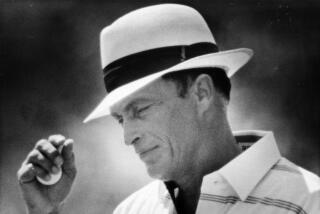GOLF : He Holds an Unequaled Position in Cuba
- Share via
HAVANA — Golf is not a Pan American Games sport, which is a good thing for the Cubans, because there are exactly two golf courses in all of Cuba. And only foreigners are allowed to play them.
In Cuba, there is exactly one golf pro, 29-year-old Jorge Duque, who plays to a seven handicap and who gives lessons at the rate of $10 per hour at the Diplo Club, near the Havana airport. He teaches diplomats and foreign businessmen on a nine-hole course built by the British in 1953 -- before the revolution -- and sold to the Cuban government in 1980.
“None of them ever make par,” Duque said of his club regulars. He smiled. “Maybe this will start a war, but some of them are very bad from Great Britain. Some from Japan are bad. 85, 90. In the 100s. Whew!”
Playing on the small, slow greens with their original 1953 Acapulco grass and the wide fairways between three-inch rough, Duque himself has an all-time best round of par 70. “It’s a tough course,” he said.
But you take what you can get. Besides the Diplo Club -- with its serene pines, mango trees, swimming pool, restaurant, two bowling lanes, and two tennis courts -- the only other golf course on this island is two hours east of Havana in Varadero, a plush new tourist resort built by Spaniards. Since there is no golf pro at Varadero, Duque literally is one of a kind in this nation of 10.5 million people.
His job is so rare, in fact, that Duque found it only through a lightning bolt of serendipity. Ten years ago, he was studying in the Havana sports school to be an instructor in water sports, and was one of four students asked if they would like to learn golf.
Golf?
“In Cuba, when you are born,” Duque said, “if you are a boy, you are playing baseball or soccer or boxing. Those are in our blood. We never think of golf. It’s not part of our life.”
But the pro at the Diplo Club, Pepe Fernandez, was getting too old for the job -- 85 -- so Duque and three others were asked if they would like to be trained for Fernandez’s job: playing and teaching golf.
Golf.
“It’s that game you play with the bag, and you hit the ball, and that’s all,” was what Duque knew of the sport at the time. “It’s like the moon. You know, it looks like this” -- he made a circle with his hands -- “and it has little holes and it’s up there.” He shrugged. Why not become a golf astronaut in Cuba and walk where others never do?
Duque was chosen to replace Fernandez over the other three students less than a year later because he had learned his English and his golf, and had a knack for communication. He can drive a ball 270 yards and is quietly engaging. He’s tall and thin, built not at all like his favorite player, Jack Nicklaus, and had been a long jumper and high jumper in school.
Of course, Duque is an anomaly. In a country where the government proclaims sport to be the “right of the people,” yet provides not a single golf course to them, Duque considers himself lucky because “when I was a kid, my father used to walk in the country with me. I liked to be with nature. This one thing, to walk a lot outdoors, made me fall in love with golf.
“And you really do what you want with the ball. It’s like being an artist: A combination of little things can make a big thing, a masterpiece.” The fact that no other young Cubans have the chance to fall in love with golf doesn’t sadden Duque, he said, “because they have so many other things to enjoy.”
It’s not a complicated equation for him. He has this job -- “I’m the only one who has this job” -- but it’s a job and he works at it. Golf Digest gets to him about two months after it hits the newsstands in other countries, brought to Duque by “my friends,” the diplomats who play at the Diplo Club. Also, his friends bring him videotapes of the U.S. television coverage of major golf championships.
“That first day 10 years ago, when we picked up a club to learn the game,” Duque said, “since our game here in Cuba is baseball, all of us took the club and held it like a baseball bat.” But he reads the tips from the pros. He watches the best on tape and he learns.
Before the 1959 revolution, when Cuba was a playground for the rich capitalists from the States, there were four golf courses in Havana alone. And Duque was told that, “in the ‘50s, Sam Snead and Ben Hogan played in Cuba, and they couldn’t make par.”
But that was then, at Colinas de Villa Real in the eastern section of Havana. The Colinas de Villa Real course has long since been built over. In its place now stands the new Pan Am Games main stadium and athletes village, built this year.
More to Read
Sign up for The Wild
We’ll help you find the best places to hike, bike and run, as well as the perfect silent spots for meditation and yoga.
You may occasionally receive promotional content from the Los Angeles Times.






